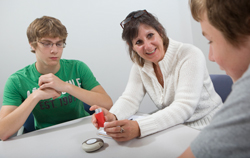 Oct. 29, 2018
Oct. 29, 2018
By Laura Reindl
For the past five years, Decker School of Nursing students in a course called Asthma-Based Research taught by Assistant Professor Judith Quaranta '79, MS '98, PhD '13 and Clinical Associate Professor Fran Srnka-Debnar '86, MS '90, PhD '15, have implemented various forms of asthma education intervention in elementary schools and Head Start classrooms throughout Broome County.
Asthma is the most common chronic health condition among children in the United States, affecting an estimated 6.2 million children according to the American Lung Association (ALA). "Asthma is the number one reason that kids miss school," says Quaranta. "So if we can keep them in school, if we can help them manage their asthma, then they're going to do better."
Every semester, Quaranta's students implement some form of asthma education program for youth in the community. Students in the course complete the ALA's facilitator training for the Open Airways for Schools curriculum, which certifies them to teach elementary school students effective ways to manage their asthma.
Jennifer Swaine '18 was enrolled in Quaranta's course for seven consecutive semesters. (Many students return to the course for multiple semesters so they can stay engaged in the research process, which rarely conforms to a single semester timeline.) She says the children she worked with generally enjoyed the five- to six-week program, and she felt like she did make a difference for them.
"They would get to be around other kids that had asthma, and I think it made them feel less alone," she says. "They all faced similar issues, so we talked about ways to circumvent [those issues]. I think it made them feel more confident in their asthma management."
Quaranta also has a long-standing relationship with Michelle Codner, the health services coordinator for Head Start programs at the Family Enrichment Network, where her students show an introductory-level video featuring Sesame Street characters called A is for Asthma. The video teaches young children the basics of asthma and how to help a friend who is having trouble breathing.
Codner says the sessions are also beneficial for the teachers and other staff. "It helps the teachers...recognize the seriousness of asthma and gives them some idea of how to determine the signs of asthma in children and what to do if they see those signs. It's also given me opportunities to reach out to parents and try to give them some teaching about asthma and encourage them to seek effective care from healthcare providers."
Quaranta and her students work with the community partner sites they visit to collect data through pretests and post-tests so they can analyze the effectiveness of their various intervention strategies.
"I want students to be interested in research," she says. "Every semester we have them do some type of intervention, we have them enter data, and then we run analysis. So they get to see the whole research process. I want them to know it's more than memorizing variables and what test goes with what. I want them to be involved in the research process so they can see that it's fun."
She also hopes the experience will convince some of them to go on to graduate school and consider a career in higher education. The average age of nursing faculty is increasing, she says. "There's a nursing shortage, but there's not enough faculty to teach the people that want to become nurses."
Quaranta is always looking for new ways to engage her students in the community-based research. This semester her class is developing a teaching model for adolescents about the risks of vaping, and she is hoping to bring that to a local high school. She is also part of a cross-disciplinary team that is exploring the possibility of a study comparing traditional face-to-face asthma intervention strategies with those administered via mobile applications and a robot with facial and voice recognition capabilities.
The potential benefits of this technology are exciting, particularly for schools in rural areas, says Quaranta. "If [the robot] is an effective teaching tool, then we don't need a person that's available to do the asthma teaching. The kids can just come [into the school nurse's office] and ask him a question, or they can go through the whole [module]."
Community Engagement Faculty Teaching Grant
Transportation is often a barrier in getting students (about 1/3 of whom do not have a car on campus) into the community. Quaranta has been able to reimburse her students for travel expenses as they visit community sites thanks to the CCE's Community Engagement Faculty Teaching Grants.